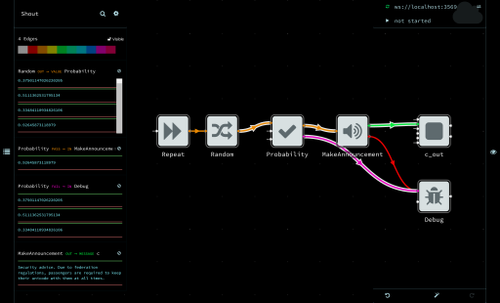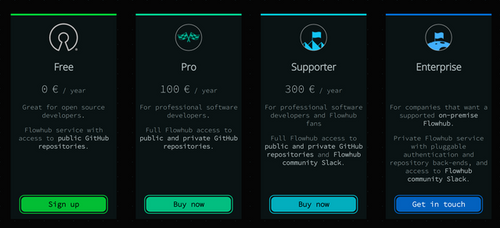Process API for NoFlo components
It has been a while that I’ve written about flow-based programming — but now that I’m putting most of my time to Flowhub things are moving really quickly.
One example is the new component API in NoFlo that has been emerging over the last year or so.
Most of the work described here was done by Vladimir Sibirov from The Grid team.
Introducing the Process API
NoFlo programs consist of graphs where different nodes are connected together. These nodes can themselves be graphs, or they can be components written in JavaScript.
A NoFlo component is simply a JavaScript module that provides a certain interface that allows NoFlo to run it. In the early days there was little convention on how to write components, but over time some conventions emerged, and with them helpers to build well-behaved components more easily.
Now with the upcoming NoFlo 0.8 release we’ve taken the best ideas from those helpers and rolled them back into the noflo.Component base class.
So, how does a component written using the Process API look like?
// Load the NoFlo interface
var noflo = require('noflo');
// Also load any other dependencies you have
var fs = require('fs');
// Implement the getComponent function that NoFlo's component loader
// uses to instantiate components to the program
exports.getComponent = function () {
// Start by instantiating a component
var c = new noflo.Component();
// Provide some metadata, including icon for visual editors
c.description = 'Reads a file from the filesystem';
c.icon = 'file';
// Declare the ports you want your component to have, including
// their data types
c.inPorts.add('in', {
datatype: 'string'
});
c.outPorts.add('out', {
datatype: 'string'
});
c.outPorts.add('error', {
datatype: 'object'
});
// Implement the processing function that gets called when the
// inport buffers have packets available
c.process(function (input, output) {
// Precondition: check that the "in" port has a data packet.
// Not necessary for single-inport components but added here
// for the sake of demonstration
if (!input.hasData('in')) {
return;
}
// Since the preconditions matched, we can read from the inport
// buffer and start processing
var filePath = input.getData('in');
fs.readFile(filePath, 'utf-8', (err, contents) {
// In case of errors we can just pass the error to the "error"
// outport
if (err) {
output.done(err);
return;
}
// Send the file contents to the "out" port
output.send({
out: contents
});
// Tell NoFlo we've finished processing
output.done();
});
});
// Finally return to component to the loader
return c;
}
Most of this is still the same component API we’ve had for quite a while: instantiation, component metadata, port declarations. What is new is the process function and that is what we’ll focus on.
When is process called?
NoFlo components call their processing function whenever they’ve received packets to any of their regular inports.
In general any new information packets received by the component cause the process function to trigger. However, there are some exceptions:
- Non-triggering ports don’t cause the function to be called
- Ports that have been set to forward brackets don’t cause the function to be called on bracket IPs, only on data
Handling preconditions
When the processing function is called, the first job is to determine if the component has received enough data to act. These “firing rules” can be used for checking things like:
- When having multiple inports, do all of them contain data packets?
- If multiple input packets are to be processed together, are all of them available?
- If receiving a stream of packets is the complete stream available?
- Any input synchronization needs in general
The NoFlo component input handler provides methods for checking the contents of the input buffer. Each of these return a boolean if the conditions are matched:
input.has('portname')whether an input buffer contains packets of any typeinput.hasData('portname')whether an input buffer contains data packetsinput.hasStream('portname')whether an input buffer contains at least one complete stream of packets
For convenience, has and hasData can be used to check multiple ports at the same time. For example:
// Fail precondition check unless both inports have a data packet
if (!input.hasData('in1', 'in2')) return;
For more complex checking it is also possible to pass a validation function to the has method. This function will get called for each information packet in the port(s) buffer:
// We want to process only when color is green
var validator = function (packet) {
if (packet.data.color === 'green') {
return true;
}
return false;
}
// Run all packets in in1 and in2 through the validator to
// check that our firing conditions are met
if (!input.has('in1', 'in2', validator)) return;
The firing rules should be checked in the beginning of the processing function before we start actually reading packets from the buffer. At that stage you can simply finish the run with a return.
Processing packets
Once your preconditions have been met, it is time to read packets from the buffers and start doing work with them.
For reading packets there are equivalent get functions to the has functions used above:
input.get('portname')read the first packet from the port’s bufferinput.getData('portname')read the first data packet, discarding preceding bracket IPs if anyinput.getStream('portname')read a whole stream of packets from the port’s buffer
For get and getStream you receive whole IP objects. For convenience, getData returns just the data payload of the data packet.
When you have read the packets you want to work with, the next step is to do whatever your component is supposed to do. Do some simple data processing, call some remote API function, or whatever. NoFlo doesn’t really care whether this is done synchronously or asynchronously.
Note: once you read packets from an inport, the component activates. After this it is necessary to finish the process by calling output.done() when you’re done.
Sending packets
While the component is active, it can send packets to any number of outports using the output.send method. This method accepts a map of port names and information packets.
output.send({
out1: new noflo.IP('data', "some data"),
out2: new noflo.IP('data', [1, 2, 3])
});
For data packets you can also just send the data as-is, and NoFlo will wrap it to an information packet.
Once you’ve finished processing, simply call output.done() to deactivate the component. There is also a convenience method that is a combination of send and done. This is useful for simple components:
c.process(function (input, output) {
var data = input.getData('in');
// We just add one to the number we received and send it out
output.sendDone({
out: data + 1
});
});
In normal situations there packets are transmitted immediately. However, when working on individual packets that are part of a stream, NoFlo components keep an output buffer to ensure that packets from the stream are transmitted in original order.
Component lifecycle
In addition to making input processing easier, the other big aspect of the Process API is to help formalize NoFlo’s component and program lifecycle.

The component lifecycle is quite similar to the program lifecycle shown above. There are three states:
- Initialized: the component has been instantiated in a NoFlo graph
- Activated: the component has read some data from inport buffers and is processing it
- Deactivated: all processing has finished
Once all components in a NoFlo network have deactivated, the whole program is finished.
Components are only allowed to do work and send packets when they’re activated. They shouldn’t do any work before receiving input packets, and should not send anything after deactivating.
Generator components
Regular NoFlo components only send data associated with input packets they’ve received. One exception is generators, a class of components that can send packets whenever something happens.
Some examples of generators include:
- Network servers that listen to requests
- Components that wait for user input like mouse clicks or text entry
- Timer loops
The same rules of “only send when activated” apply also to generators. However, they can utilize the processing context to self-activate as needed:
exports.getComponent = function () {
var c = new noflo.Component();
c.inPorts.add('start', { datatype: 'bang' });
c.inPorts.add('stop', { datatype: 'bang' });
c.outPorts.add('out', { datatype: 'bang' });
// Generators generally want to send data immediately and
// not buffer
c.autoOrdering = false;
// Helper function for clearing a running timer loop
var cleanup = function () {
// Clear the timer
clearInterval(c.timer.interval);
// Then deactivate the long-running context
c.timer.deactivate();
c.timer = null;
}
// Receive the context together with input and output
c.process(function (input, output, context) {
if (input.hasData('start')) {
// We've received a packet to the "start" port
// Stop the previous interval and deactivate it, if any
if (c.timer) {
cleanup();
}
// Activate the context by reading the packet
input.getData('start');
// Set the activated context to component so it can
// be deactivated from the outside
c.timer = context
// Start generating packets
c.timer.interval = setInterval(function () {
// Send a packet
output.send({
out: true
});
}, 100);
// Since we keep the generator running we don't
// call done here
}
if (input.hasData('stop')) {
// We've received a packet to the "stop" port
input.getData('stop');
if (!c.timer) {
// No timers running, we can just finish here
output.done();
return;
}
// Stop the interval and deactivate
cleanup();
// Also call done for this one
output.done();
}
});
// We also may need to clear the timer at network shutdown
c.tearDown = function (callback) {
if (c.timer) {
// Stop the interval and deactivate
cleanup();
}
c.emit('end');
c.started = false;
callback();
}
return c;
}
Time to prepare
NoFlo 0.7 included a preview version of the Process API. However, last week during the 33C3 conference we finished some tricky bits related to process lifecycle and automatic bracket forwarding that make it more useful for real-life NoFlo applications.
These improvements will land in NoFlo 0.8, due out soon.
So, if you’re maintaining a NoFlo application, now is a good time to give the git version a spin and look at porting your components to the new API. Make sure to report any issues you encounter!
We’re currently migrating all the hundred-plus NoFlo open source modules to latest build and testing process so that they can be easily updated to the new APIs when they land.

